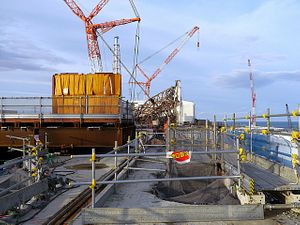This week has been a mixed bag for Japanese utilities, energy consumers, and the victims of the 2011 Fukushima Daiichi nuclear disaster. Probably the biggest and most hopeful piece of news came from the cleanup efforts at Daiichi Nuclear Power Plant. In what is perhaps unfortunately being termed as a “rare success,” the Tokyo Electric Power Co (TEPCO) has announced the removal of some 400 tons of spent fuel rods from reactor No. 4’s upper levels. This achievement represents roughly a quarter of the amount of uranium fuel that TEPCO needs to remove and safely store, yet the cleanup effort is still expected to last “decades” according to a Reuters report.
TEPCO still needs to remove assemblies and fuel rods from three other reactors, although No. 4 appears to have been a significant cause of concern as it was considered to be vulnerable to another earthquake which could have exposed the spent fuel rods. There are still 1,400 fuel assemblies that must be removed from the remaining reactors that will most likely be placed in reactor No. 6, which was not damaged by the earthquake or tsunami in 2011. The removal of spent fuel and assemblies is only the initial step for TEPCO, however. It must still “address the most difficult task of extracting the three reactor cores that melted during the crisis, an unprecedented occurrence.” While there is no reliable estimate as to how long extracting the reactor cores will take, the government expects the removal of fuel to last until around 2025 “because of holdups in the decommissioning work,” according to Kyodo News.
News of the scale and time frame of the Fukushima clean-up helps to put the possible restart of Kyushu Electric Power Co.’s Sendai reactors in perspective, which is currently being debated by the Kagoshima prefectural assembly. To put local communities more at ease with the restart, particularly in light of the recent unexpected volcanic eruption at Mt. Ontake, the Nuclear Regulation Authority’s (NRA) Chairman Shunichi Tanaka said that in the event of a large nearby volcanic eruption (for instance, the still active Mt. Sakurajima), Sendai’s nuclear fuel could be safely transferred within three months. This would require that Japanese scientists accurately predict such an eruption within that timeframe. The Jiji Press reported Tanaka saying “It would be possible to stop the plant and start preparations immediately to transfer (nuclear fuel) into containers little by little and transport them to distant places,” however he could not fully explain how or where the fuel would be safely removed.
For local residents still struggling to rebuild their lives after the 2011 tragedy, there is more frustrating news. A Reuters investigation into bank deposit information and budgets for officials in Miyagi, Iwate and Fukushima prefectures revealed that of the $50 billion in government funds given to these local governments for reconstruction, $30 billion is still sitting unspent in regional banks. While local citizens have made repeated protests to local officials to use the funds and begin rebuilding, local officials complain of central government red tape delaying the approval of building plans, and still others say that the initial budgeting for projects such as new homes did not reflect the recent increase in cost for building materials, which is hampering their ability to find construction firms willing to do the work.
For Japan’s major utility companies, the news has been better as of late. An earnings report released last Friday showed that TEPCO and eight other regional utilities recorded annualized profits from April to September at 242.8 billion yen ($2.1 billion). These numbers are higher than even those recorded just prior to the March 2011 disaster, with the companies attributing them to a “postponement of equipment renovation and higher efficiency in thermal power plant operations.”
One of the two utilities to fail to record a profit, Hokkaido Electric Power Co., on Saturday announced that it would be raising costs for household consumers by 12.43 percent. Prices for businesses also rose, up 16.48 percent. While Hokkaido used to enjoy some of the lowest energy prices in Japan, it now has some of the highest. Household consumers can expect their November monthly rate to increase 856 yen, to 8,198 yen.

































